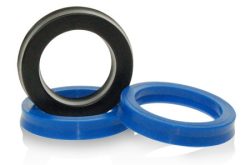Rod Seals Explained, What is a Rod Seal?
A Beginner’s Guide To Rod Seals
Rod Function:
The rod, also known as the piston rod, plays a crucial role in hydraulic cylinders by converting hydraulic energy into linear mechanical movement. It absorbs hydraulic pressure from the piston, transmitting it to the object or load for movement.
To ensure smooth movement and prevent metal-on-metal contact with the cylinder head, guide rings or tapes guide the rod and piston. This guidance maintains precision and linearity and absorbs and balances lateral forces caused by external factors or vibrations.
Rods can have various configurations, such as threaded ends for attaching different accessories. The rod length is adjustable based on specific needs, considering stroke length and required movement.
Rod Seal Function:
Rod seals are crucial for preventing hydraulic fluid leakage in cylinders. Equipped with seals, the rod maintains hydraulic pressure within the cylinder, preventing fluid from escaping between the rod and cylinder head and ensuring efficient operation.
A typical rod sealing system consists of guide rings/tapes, rod seals, and wipers arranged consecutively.
Materials:
Rod seals come in a variety of materials based on requirements. Polyurethane seals are popular due to their high abrasion resistance, mechanical strength, and resistance to hydraulic fluids. They provide excellent sealing and offer a long service life, making them suitable for harsh operating conditions.
Design & Features:
Rods are usually made of high-tensile steel to withstand the substantial loads encountered during operation. Precise manufacturing ensures optimal sealing. The seal’s profile and material can be chosen for friction optimisation depending on requirements.
Moreover, the dimensions of the rod seal, including inner and outer diameter, height, and tolerances, must be designed to fit the specified housing space.
When crafting rod seals, it is crucial to focus on the design of the installation space. Thoughtful considerations and planning before the application can prevent issues like gap extrusion. This proactive approach not only enhances the seal’s functionality but also extends its service life. By addressing these factors beforehand, potential challenges can be mitigated, contributing to improved overall performance.
To find out more about our Rod Seals, download our 24-Hour Seal Maker Brochure (Pages 5 and 6). For more technical information visit the Types of Hydraulic Seals and Hydraulic and Pneumatics pages.
E & OE. M Barnwell Services endeavour to make sure that all content is correct. The information has been gathered from manufacturing partners.
